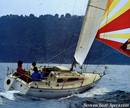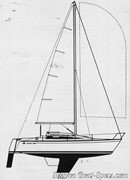First 26 Fin keel
Sailboat specifications
The First 26 is a 25’5” (7.75m) cruiser-racer sailboat designed by Finot Conq Architectes (France). She was built between 1984 and 1989 by Bénéteau (France). The Fin keel version adopts a classical fin configuration, the easiest option to provide a low center of gravity.
The First 26 is as well listed, on Boat-Specs.com, in Swing keel version (see all the versions compared).
The First 26 is as well listed, on Boat-Specs.com, in Swing keel version (see all the versions compared).
First 26's main features
- Model
- First 26
- Version
- Fin keel
- Hull type
- Monohull
- Category
- Cruiser-racer sailboat
- Sailboat builder
- Sailboat designer
- Sailboat range
- Country
- France
- Construction
- Hull and deck: GRP (glass reinforced polyester)
- Number of hulls built
- About 300
- First built hull
- 1984
- Last built hull
- 1989
- Appendages
- Keel : fin without bulb
- Helm
- Single tiller
- Rudder
- Single transom hung rudder
- Unsinkable
- No
- Trailerable
- No
- Former French navigation category
- 3
- Standard public price ex. VAT (indicative only)
- N/A €
First 26's main dimensions
- Overall length
- 26’ 11”8.2 m
- Hull length
- 25’ 5”7.75 m
- Waterline length
- 23’7 m
- Beam (width)
- 9’ 2”2.8 m
- Draft
- 4’ 4”1.3 m
- Light displacement (MLC)
- 4409 lb2000 kg
- Ballast weight
- 1455 lb660 kg
- French customs tonnage
- 5.80 Tx
First 26's rig and sails
- Upwind sail area
- 411 ft²38.2 m²
- Downwind sail area
- 743 ft²69 m²
- Mainsail area
- 140 ft²13 m²
- Genoa area
- 271 ft²25.2 m²
- Jib area
- 110 ft²10.2 m²
- Stormjib area
- 45 ft²4.2 m²
- Symmetric spinnaker area
- 603 ft²56 m²
- Rigging type
- Sloop Marconi masthead
- Mast configuration
- Deck stepped mast
- Rotating spars
- No
- Number of levels of spreaders
- 1
- Spreaders angle
- 0 °
- Spars construction
- Aluminum spars
- Standing rigging
- 1x19 strand wire continuous
First 26's performances
- Upwind sail area to displacementiThe ratio sail area to displacement is obtained by dividing the sail area by the boat's displaced volume to the power two-thirds.
The ratio sail area to displacement can be used to compare the relative sail plan of different sailboats no matter what their size.
Upwind: under 18 the ratio indicates a cruise oriented sailboat with limited performances especially in light wind, while over 25 it indicates a fast sailboat. - 259 ft²/T24.06 m²/T
- Downwind sail area to displacementiThe ratio sail area to displacement is obtained by dividing the sail area by the boat's displaced volume to the power two-thirds.
The ratio sail area to displacement can be used to compare the relative sail plan of different sailboats no matter what their size. - 468 ft²/T43.47 m²/T
- Displacement-length ratio (DLR)iThe Displacement Length Ratio (DLR) is a figure that points out the boat's weight compared to its waterline length. The DLR is obtained by dividing the boat's displacement in tons by the cube of one one-hundredth of the waterline length (in feet).
The DLR can be used to compare the relative mass of different sailboats no matter what their length:
a DLR less than 180 is indicative of a really light sailboat (race boat made for planning), while a DLR greater than 300 is indicative of a heavy cruising sailboat. - 165
- Ballast ratioiThe Ballast ratio is an indicator of stability; it is obtained by dividing the boat's displacement by the mass of the ballast. Since the stability depends also of the hull shapes and the position of the center of gravity, only the boats with similar ballast arrangements and hull shapes should be compared.
The higher the ballast ratio is, the greater is the stability. - 33 %
- Critical hull speediAs a ship moves in the water, it creates standing waves that oppose its movement. This effect increases dramatically the resistance when the boat reaches a speed-length ratio (speed-length ratio is the ratio between the speed in knots and the square root of the waterline length in feet) of about 1.2 (corresponding to a Froude Number of 0.35) . This very sharp rise in resistance, between speed-length ratio of 1.2 to 1.5, is insurmountable for heavy sailboats and so becomes an apparent barrier. This leads to the concept of "hull speed".
The hull speed is obtained by multiplying the square root of the waterline length (in feet) by 1.34. - 6.42 knots
First 26's auxiliary engine
- Engine(s)
- 1 outboard or inboard engine
- Engine(s) power
- 8 HP
- Fuel type
- Diesel for inboard engine, gas for outboard
- Fuel tank capacity
- 6.6 gal25 liters
First 26's accommodations and layout
- Cockpit
- Closed aft cockpit
- Cabin(s)
- 1
- Berth(s) (min./max.)
- 2 / 5
- Head(s) (min./max.)
- / 1
- Freshwater tank capacity
- 13.2 gal50 liters
- Maximum headroom
- 5’ 10”1.77 m









Bénéteau First 26 interior and accommodations - - 8/10
Picture extracted from the commercial documentation © Bénéteau
Picture extracted from the commercial documentation © Bénéteau


Bénéteau First 26 interior and accommodations - - 9/10
Picture extracted from the commercial documentation © Bénéteau
Picture extracted from the commercial documentation © Bénéteau


Bénéteau First 26 interior and accommodations - - 10/10
Picture extracted from the commercial documentation © Bénéteau
Picture extracted from the commercial documentation © Bénéteau
Similar sailboats that may interest you:
Sailboats
First built hull
Hull length
1982
24’ 7”7.5 m
1983
27’ 11”8.5 m
1980
28’ 2”8.6 m
1977
28’ 11”8.8 m
1971
30’9.14 m
1978
25’ 6”7.77 m
1983
27’ 11”8.5 m
1986
21’ 7”6.57 m
1990
26’7.93 m
1987
27’ 2”8.3 m
2002
27’ 2”8.3 m
1979
24’ 10”7.55 m
1977
28’ 11”8.8 m
1997
31’ 2”9.5 m
1978
21’ 7”6.58 m